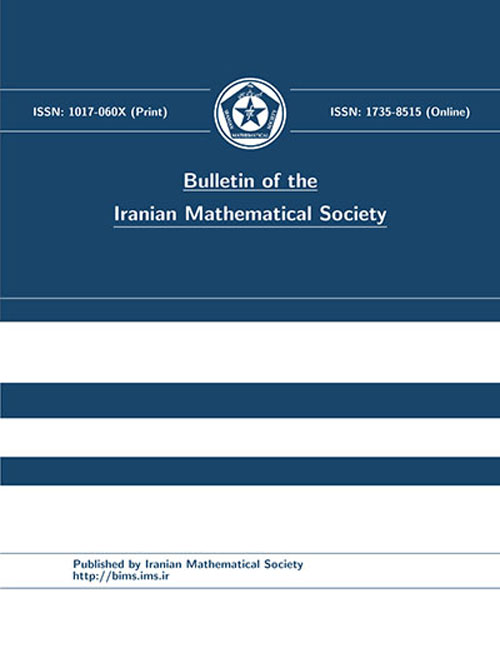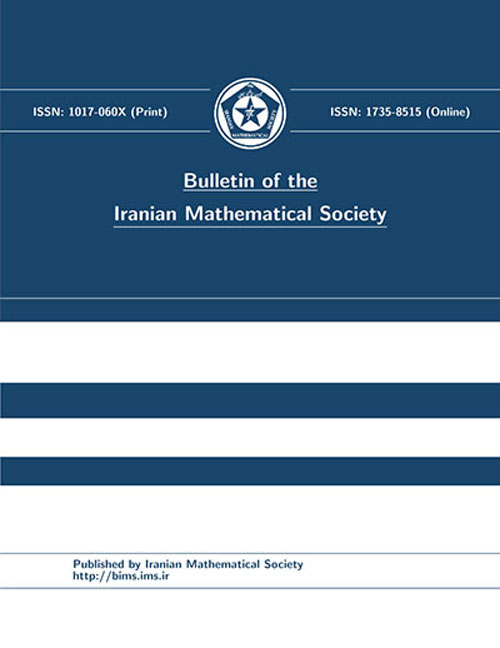فهرست مطالب

Bulletin of Iranian Mathematical Society
Volume:43 Issue: 2, 2017
- تاریخ انتشار: 1396/01/25
- تعداد عناوین: 20
-
-
Pages 259-273Let G be an automorphism group of aý ý2-(v,k,4) symmetric design Dý. ýIn this paperý, ýweý ýprove that if G is flag-transitive point-primitiveý, ýthen theý ýsocle of G cannot be an exceptional group of Lie typeý.Keywords: Symmetric designý, ýflag-transitiveý, ýpoint-primitiveý, ýexceptional simple groupý
-
Pages 275-283There are many long-standing conjectures related with some labellings of trees. It is important to connect labellings that are related with conjectures. We find some connections between known labellings of simple graphs.Keywords: trees, (odd-)graceful labellings, felicitous lalbellings, (k, d)-graceful labellings
-
Pages 285-289Let Xý, ýY and Z be Banach spaces and f:X×Yýý⟶Z a bounded bilinear mapý. ýIn this paper weý ýstudy the relation between Arens regularity of f and theý ýreflexivity of Yý. ýWe also give some conditions under which theý ýArens regularity of a Banach algebra A implies the Arensý ýregularity of certain Banach right module action of A.Keywords: Banach algebra, bilinear map, Arens product, second dual, Banach module action
-
Pages 291-305In this paper we introduce continuous g-Bessel multipliers in Hilbert spaces and investigate some of their properties. We provide some conditions under which a continuous g-Bessel multiplier is a compact operator. Also, we show the continuous dependency of continuous g -Bessel multipliers on their parameters.Keywords: g-frames, continuous frames, continuous g-frames, Multiplier of frames, Multiplier of continuous g-frames
-
Pages 307-318In this paper we apply hybrid functions of general block-pulseý ýfunctions and Legendre polynomials for solving linear andý ýnonlinear multi-order fractional differential equations (FDEs)ý. ýOur approach is based on incorporating operational matrices ofý ýFDEs with hybrid functions that reduces the FDEs problems toý ýthe solution of algebraic systemsý. ýError estimate that verifies aý ýconvergence of the approximate solutions is consideredý. ýTheý ýnumerical results obtained by this scheme have been compared withý ýthe exact solution to show the efficiency of the methodý.Keywords: Fractional derivatives, integrals?, ?multi-order fractional differential equations?, ?operational matrix?, ?hybrid functions?
-
Pages 319-336For a graph G, let P(G,lambda) denote the chromatic polynomial of G. Two graphs G and H are chromatically equivalent if they share the same chromatic polynomial. A graph G is chromatically unique if any graph chromatically equivalent to G is isomorphic to G. A K4-homeomorph is a subdivision of the complete graph K4. In this paper, we determine a family of chromatically unique K4 -homeomorphs which have girth 9 and has exactly one path of length 1, and give sufficient and necessary condition for the graphs in this family to be chromatically unique.Keywords: Chromatic polynomial, chromatically unique, K4-homeomorphs
-
Pages 337-347Based on a definition for circle in Finsler spaceý, ýrecently proposed by one of the present authors and Zý. ýShený, ýa natural definition of extrinsic sphere in Finsler geometry is given and it is shown that a connected submanifold of a Finsler manifold is totally umbilical and has non-zero parallel mean curvature vector fieldý, ýif and only if its circles coincide with circles of the ambient manifoldý.
Finallyý, ýsome examples of extrinsic sphere in Finsler geometryý, ýparticularly in Randers spaces are given.Keywords: Finsler space?, ?development?, ?mean curvature?, ?umbilical?, ?extrinsic sphere? -
Pages 349-371Our contribution in this paper is to propose an iterative algorithm which does not require prior knowledge of operator norm and prove a strong convergence theorem for approximating a solution of split equality fixed point problem for quasi-nonexpansive mappings in a real Hilbert spaceý. ýSo many have used algorithms involving the operator norm for solving split equality fixed point problemý, ýbut as widely known the computation of these algorithms may be difficult and for this reasoný, ýsome researchers have recently started constructing iterative algorithms with a way of selecting the step-sizes such that the implementation of the algorithm does not require the calculation or estimation of the operator normý. ýTo the best of our knowledge most of the works in literature that do not involve the calculation or estimation of the operator norm only obtained weak convergence resultsý. ýIn this paper, by appropriately modifying the simultaneous iterative algorithm introduced by Zhaoý, ýwe state and prove a strong convergence result for solving split equality problemý. ýWe present some applications of our result and then give some numerical example to study its efficiency and implementation at the end of the paperý.Keywords: Strong convergenceý, ýsplit equality fixed point problemý, ýquasi-nonexpansive mappingsý, ýsimultaneous iterative algorithmý, ýHilbert spacesý
-
Pages 373-384In this paperý, ýwe consider the multipoint boundary value problem for one-dimensional p-Laplacianý ýdynamic equation on time scalesý. ýWe prove the existence at least three positive solutions of the boundaryý ývalue problem by using the Avery and Peterson fixed point theoremý. ýThe interesting point is that the non-linear term f involves a first-order derivative explicitlyý. ýOur results are new for the special cases of difference equations and differential equations as well as in the general time scale settingý.Keywords: Time scales, Boundary value problem, p-Laplacian, positive solutions, fixed point theorem
-
Pages 385-408In this paperý, ýwe consider a new study about fractional Δ-difference equationsý. ýWe consider two special classes of Sturm-Liouville problems equipped with fractional Δ-difference operatorsý. ýIn couple of stepsý, ýthe Lyapunov type inequalities for both classes will be obtainedý. ýAs applicationý, ýsome qualitative behaviour of mentioned fractional problems such as stabilityý, ýspectralý, ýdisconjugacy and some interesting results about zeros of (oscillatory) solutions will be concluded.Keywords: Discrete fractional calculus?, ?discrete fractional Sturm-Liouville problem?, ?Lyapunov type inequalities?, ?stability?, ?Mittag-Leffler type functions?
-
Pages 409-425In this paperý, ýwe shall establish some extended Simpson-type inequalitiesý ýfor differentiable convex functions and differentiable concave functionsý ýwhich are connected with Hermite-Hadamard inequalityý. ýSome error estimatesý ýfor the midpointý, ýtrapezoidal and Simpson formula are also givený.Keywords: Hermite-Hadamard inequalityý, ýSimpson inequalityý, ýmidpointý ýinequalityý, ýtrapezoid inequalityý, ýconvex functioný, ýconcave functionsý, ýspecial meansý, ýquadrature rulesý
-
Pages 427-437Let A be a unital Banach algebraý, ýM be a left A-moduleý, ýand W in Z(A) be a left separating point of Mý. ýWe show that if M is a unital left A-module and δ is a linear mapping from A into Mý, ýthen the following four conditions are equivalentý: ý(i) δ is a Jordan left derivation; (ii)δ is left derivable at W; (iii) δ is Jordan left derivable at W; (iv)Aδ(B)δ(A)=δ(W) for each A,B in A with AB=BA=Wý.
ýLet A have property (B) (see Definition ???)ý, ýM be a Banach left A-moduleý, ýand δ be a continuous linear operator from A into Mý. ýThen δ is a generalized Jordan left derivation if and only if δ is Jordan left derivable at zeroý. ýIn additioný, ýif there exists an element C∈Z(A) which is a left separating point of Mý, ýand RannM(A)={0}ý, ýthen δ is a generalized left derivation if and only if δ
is left derivable at zero.Keywords: (Jordan) left derivation?, ?generalized (Jordan) left derivation?, ?(Jordan) left derivable mapping? -
Pages 439-454The Steiner distance of a graphý, ýintroduced by Chartrandý, ýOellermanný, ýTian and Zou in 1989ý, ýis a natural generalization of theý ýconcept of classical graph distanceý. ýFor a connected graph G ofý ýorder at least 2 and S⊆V(G)ý, ýthe Steinerý ýdistance d(S) among the vertices of S is the minimum size amongý ýall connected subgraphs whose vertex sets contain Sý. ýLet n,k beý ýtwo integers with 2≤k≤ný. ýThen the Steinerý ýk-eccentricity ek(v) of a vertex v of G is defined byý ýek(v)=max{d(S)|S⊆V(G)ý,|S|=ký,andv∈Sýý}ý. ýFurthermoreý, ýthe Steiner k-diameter of G isý ýsdiamk(G)=max{ek(v)|ýv∈V(G)}ý. ýIn 2011ý, ýChartrandý, ýOkamoto and Zhang showed that k−1≤sdiamk(G)≤n−1ý. ýIn thisý ýpaperý, ýgraphs with sdiam3(G)=2,3,n−1 are characterizedý, ýrespectivelyý. ýWe also consider the Nordhaus-Gaddum-type results forý ýthe parameter sdiamk(G)ý. ýWe determine sharp upper and lowerý ýbounds of sdiamk(G)뇘骚(G¯¯¯¯) and sdiamk(G)⋅ýýsdiamk(G¯¯¯¯) for a graph G of order ný. ýSomeý ýgraph classes attaining these bounds are also given.Keywords: Diameterý, ýSteiner treeý, ýSteiner k-diameterý, ýcomplementary graph
-
Pages 455-466We first study some propertiesý ýof A-module homomorphisms θ:X→Yý, ýwhere Xý ýand Y are Fréchet A-modules and A is a unitalý ýFréchet algebraý. ýThen we show that if there exists aý ýcontinued bisection of the identity for Aý, ýthen θ isý ýautomatically continuous under certain condition on Xý. ýIný ýparticularý, ýevery homomorphism from A into certainý ýFréchet algebras (including Banach algebra) is automaticallyý ýcontinuousý. ýFinallyý, ýwe show that every unital Fréchetý ýalgebra with a continued bisection of the identityý, ýisý ýfunctionally continuousý.Keywords: ?Automatic continuity?, ?Fréchet algebras?, module homomorphism?, continued bisection of the identity?, ?Fréchet A-module
-
Pages 467-475In this article we consider the sequences of sample and population covariance operators for a sequence of arrays of Hilbertian random elements. Then under the assumptions that sequences of the covariance operators norm are uniformly bounded and the sequences of the principal component scores are uniformly sumable, we prove that the convergence of the sequences of covariance operators would imply the convergence of the corresponding sequences of the sample and population eigenvalues and eigenvectors, and vice versa. In particular we prove that the principal component scores converge in distribution in certain family of Hilbertian elliptically contoured distributions.Keywords: Hilbertian random elements?, ?functional data? ?analysis?, ?functional principal component analysis?, ?covariance? ?operators?, ?operator convergence?.s
-
Pages 477-499The aim of this paper is to compute a simplicial cohomology group of some specific digital images. Then we define ringand algebra structures of a digital cohomology with the cup product. Finally, we prove a special case of the Borsuk-Ulam theorem fordigital images.Keywords: Digital simplicial cohomology group, cup product, cohomology ring, cohomology algebra
-
Pages 501-514In this paper, it is proved that all simple K4-groups of type L2(q) can be characterized by their maximum element orders together with their orders. Furthermore, the automorphism groups of simple K4-groups of type L2(q) are also considered.Keywords: Simple K4-groups, maximum element order, characterization
-
Pages 515-534At present paper, we establish the existence of pullback D-attractor for the process associated with non-autonomous partly dissipative reaction-diffusion equation in L2(Rn)×L2(Rn). In order to do this, by energy equation method we show that the process, which possesses a pullback D-absorbing set, is pullback D0 -asymptotically compact.Keywords: Pullback? ?attractors?, ?partly dissipative?, ?reaction-diffusion? ?equations?
-
Comparative study on solving fractional differential equations via shifted Jacobi collocation methodPages 535-560In this paper, operational matrices of Riemann-Liouville fractional integration and Caputo fractional differentiation for shifted Jacobi polynomials are considered. Using the given initial conditions, we transform the fractional differential equation (FDE) into a modified fractional differential equation with zero initial conditions. Next, all the existing functions in modified differential equation are approximated by shifted Jacobi polynomials. Then, operational matrices and spectral collocation method are applied to obtain a linear or nonlinear system of algebraic equations. System of algebraic equations can be simultaneously solved (e.g. using Mathematica^{TM}). Main characteristic behind of the this technique is that only a small number of shifted Jacobi polynomials is needed to obtain a satisfactory result which demonstrates the validity and efficiency of the method. Comparison between this method and some other methods confirm the good performance of the presented method. Also, this method is generalized for the multi-point fractional differential equation.Keywords: Fractional-order differential equation, Riemann-Liouville integral, Jacobi polynomial, collocation method
-
Pages 561-574In this article, we discuss measure theoretic characterizations for weighted composition operators in some operator classes on L2(Σ) such as, n-power normal, n-power quasi-normal, k-quasi-paranormal and quasi-class A. Then we show that weighted composition operators can separate these classes.Keywords: conditional expectation, weighted composition operator, n-power normal, k-quasi-paranormal


